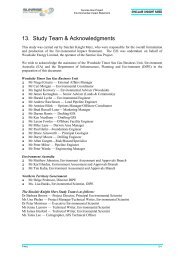Appendix D Terrestrial and Aquatic Biodiversity - Environment ...
Appendix D Terrestrial and Aquatic Biodiversity - Environment ...
Appendix D Terrestrial and Aquatic Biodiversity - Environment ...
Create successful ePaper yourself
Turn your PDF publications into a flip-book with our unique Google optimized e-Paper software.
SZ247: Bat survey from the Western Desert Resources Towns River project area, NT<br />
5.0 DISCUSSION<br />
5.1 Bat diversity<br />
A total of 22 species are likely to be present in the Roper River – Limmen – Borroloola region<br />
based on compiled records <strong>and</strong> derived distribution limits in Milne <strong>and</strong> Pavey (2011) (Table 1).<br />
Within any one locality, the species assemblage is likely to contain fewer species than this<br />
regional total, on the basis of the habitats present. In the case of the MLA – Towns River<br />
project area, the absence of cave roosting bats such as Hipposideros ater, Rhinonicteris<br />
aurantia, Vespadelus caurinus <strong>and</strong> V. finlaysoni may be explained by the absence of<br />
significant rocky outcrop <strong>and</strong> rock types prone to cave development within a few kilometres of<br />
the locality, while the presence of Taphozous georgianus is explained by their relatively large<br />
capacity for long distance flight based on wing morphology (e.g. Bullen <strong>and</strong> McKenzie 2002).<br />
In addition, the absence of species such as Mormopterus loriae cobourgiana, Pipistrellus<br />
westralis <strong>and</strong> Nyctophilus arnhemensis is not surprising given the distance from coastal<br />
habitats, which these species appear to prefer (e.g. Churchill 2008).<br />
In the case of haul road sites (Limmen River, Rosie Creek), there were more species detected,<br />
with the additional species roosting in caves during the day: Rhinonicteris aurantia <strong>and</strong><br />
Vespadelus caurinus. The addition of cave forming rock promotes biodiversity <strong>and</strong><br />
increases the habitat value of those localities. In the case of the proposed port site at Bing<br />
Bong, bat richness was relatively low compared to other sites (acoustic records available only,<br />
<strong>and</strong> bearing in mind relative acoustic sampling effort), but further future effort might detect<br />
species that prefer mangal <strong>and</strong> other coastal habitats such as Mormopterus loriae,<br />
Nyctophilus arnhemensis <strong>and</strong> Pipistrellus westralis.<br />
Overall bat diversity in the MLA – Towns River project area was moderate, with only eight<br />
species detected. Most of these were tree-roosting species, with the exception of<br />
Taphozous georgianus, which roosts in caves <strong>and</strong> could have reached the project area from<br />
roosts located several kilometres away, given the observed lack of significant cave-forming<br />
rocky outcrop in the project area. The combination of both acoustic recordings <strong>and</strong> trapping<br />
was valuable in terms of maximising the detection of species for two reasons: 1. most species<br />
could be identified from multiple sites (=habitat types) within the project area with minimal<br />
effort <strong>and</strong> based on reference acoustic signatures described by Milne (2002); <strong>and</strong> 2. for<br />
situations where two species could not be differentiated from each other because of their very<br />
similar echolocation call characteristics, trapping was able to confirm the presence of both<br />
c<strong>and</strong>idates in the project area (e.g. Chalinolobus nigrogriseus <strong>and</strong> Scotorepens greyii) or<br />
indicate which of several c<strong>and</strong>idates could be confirmed at a minimum (e.g. Nyctophilus<br />
geoffroyi).<br />
Bats captured in mist nets <strong>and</strong> harp traps could be identified reliably to genus level based on<br />
descriptions in field guides such as Churchill (2008), however there was some potential for<br />
both misidentification or the presence of cryptic taxa at the species level. DNA barcoding<br />
was used to verify the putative species level identifications. While publically available<br />
genetic context data from Australian bat species is generally lacking, which prevented the<br />
association of the DNA barcodes with reference genetic sequences from known species (at<br />
least within the timeframe of this study), the amount of genetic variation within clades (= main<br />
branches) of each phylogram was relatively small, indicating that only one species was<br />
present per genus. However, in the case of small vespertilionids putatively attributable to<br />
Page 15 of 33



